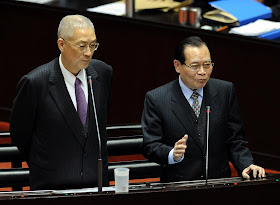 Whether the DF-16 is the real deal, a variant of an existing missile or a medium-range ballistic missile known to US intelligence is more than semantics
Whether the DF-16 is the real deal, a variant of an existing missile or a medium-range ballistic missile known to US intelligence is more than semanticsThe lack of US intelligence on a new type of short-range ballistic missile allegedly deployed by China has led some defense specialists to conclude that the projectile could be a medium-range missile already known to US authorities.
Debate over the existence of the Dong Feng-16 (DF-16, 東風16) emerged soon after National Security Bureau (NSB) Director Tsai Der-sheng (蔡得勝) informed the legislature on March 16 that his agency had intelligence proving that the People’s Liberation Army (PLA) had finished testing and had deployed a new type of missile. In his testimony, Tsai said that some of the missiles, with a range of between 800km and 1,000km, were targeting Taiwan.
The faster re-entry of a longer-range ballistic missile, experts said, would make it more difficult for interceptors, such as Taiwan’s PAC-3, to defend against them.
With scant specific references in the literature and no confirmation from other intelligence agencies, some experts have wondered whether Tsai’s DF-16 might not be a variant of an existing short-range ballistic missile (SRBM), such as the DF-11 or DF-15, of which more than 1,000 are targeted at Taiwan.
However, some defense specialists approached by the
Taipei Times said that as older SRBMs had been developed in the 1980s and fielded in the 1990s, it would not be surprising, as per industrial cycles, for an altogether new type of missile to be developed.
While variants of a missile are indicative of minor design improvements — for example, the DF-15C, which some reports say could serve as a longer-range upgrade at the Second Artillery’s Leping SRBM Brigade in Jiangxi Province — new designations, such as the DF-16, imply fundamental design changes, such as advances in solid rocket fuel, guidance systems and warhead design.
However, the lack of specifics provided by Tsai, who claimed Taiwan had sources unavailable to its allies, has led some analysts to conclude that rather than a brand new type of SRBM, the DF-16 could in fact be a medium-range ballistic missile (MRBM) already known to US intelligence, the CSS-X-11.
My article, published today in the
Taipei Times, continues
here.
 Since President Ma Ying-jeou launched his policy of détente with China, the assumption has been that Beijing would reduce its military and intelligence stance towards Taiwan. That view is a dangerous misreading of China’s strategy
Since President Ma Ying-jeou launched his policy of détente with China, the assumption has been that Beijing would reduce its military and intelligence stance towards Taiwan. That view is a dangerous misreading of China’s strategy



















